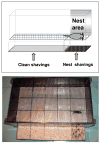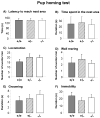Reduced ultrasonic vocalizations in vasopressin 1b knockout mice
- PMID: 18005969
- PMCID: PMC2255061
- DOI: 10.1016/j.bbr.2007.09.034
Reduced ultrasonic vocalizations in vasopressin 1b knockout mice
Abstract
The neuropeptides oxytocin and vasopressin have been implicated in rodent social and affiliative behaviors, including social bonding, parental care, social recognition, social memory, vocalizations, territoriality, and aggression, as well as components of human social behaviors and the etiology of autism. Previous investigations of mice with various manipulations of the oxytocin and vasopressin systems reported unusual levels of ultrasonic vocalizations in social settings. We employed a vasopressin 1b receptor (Avpr1b) knockout mouse to evaluate the role of the vasopressin 1b receptor subtype in the emission of ultrasonic vocalizations in adult and infant mice. Avpr1b null mutant female mice emitted fewer ultrasonic vocalizations, and their vocalizations were generally at lower frequencies, during a resident-intruder test. Avpr1b null mutant pups emitted ultrasonic vocalizations similar to heterozygote and wildtype littermates when separated from the nest on postnatal days 3, 6, 9, and 12. However, maternal potentiation of ultrasonic vocalizations in Avpr1b null and heterozygote mutants was absent, when tested at postnatal day 9. These results indicate that Avpr1b null mutant mice are impaired in the modulation of ultrasonic vocalizations within different social contexts at infant and adult ages.
Figures




Similar articles
-
Role of the vasopressin 1b receptor in rodent aggressive behavior and synaptic plasticity in hippocampal area CA2.Mol Psychiatry. 2015 Apr;20(4):490-9. doi: 10.1038/mp.2014.47. Epub 2014 May 27. Mol Psychiatry. 2015. PMID: 24863146 Free PMC article.
-
Persistence of reduced aggression in vasopressin 1b receptor knockout mice on a more "wild" background.Physiol Behav. 2009 Apr 20;97(1):131-4. doi: 10.1016/j.physbeh.2009.02.006. Epub 2009 Feb 11. Physiol Behav. 2009. PMID: 19419666 Free PMC article.
-
Social dominance in male vasopressin 1b receptor knockout mice.Horm Behav. 2010 Jul;58(2):257-63. doi: 10.1016/j.yhbeh.2010.03.008. Epub 2010 Mar 16. Horm Behav. 2010. PMID: 20298692 Free PMC article.
-
The vasopressin 1b receptor and the neural regulation of social behavior.Horm Behav. 2012 Mar;61(3):277-82. doi: 10.1016/j.yhbeh.2011.11.009. Epub 2011 Dec 7. Horm Behav. 2012. PMID: 22178035 Free PMC article. Review.
-
Types and functions of ultrasonic vocalizations in laboratory rats and mice.J Am Assoc Lab Anim Sci. 2007 Jan;46(1):28-34. J Am Assoc Lab Anim Sci. 2007. PMID: 17203913 Review.
Cited by
-
Discrimination of ultrasonic vocalizations by CBA/CaJ mice (Mus musculus) is related to spectrotemporal dissimilarity of vocalizations.PLoS One. 2014 Jan 9;9(1):e85405. doi: 10.1371/journal.pone.0085405. eCollection 2014. PLoS One. 2014. PMID: 24416405 Free PMC article.
-
Ultrasonic vocalizations induced by sex and amphetamine in M2, M4, M5 muscarinic and D2 dopamine receptor knockout mice.PLoS One. 2008 Apr 2;3(4):e1893. doi: 10.1371/journal.pone.0001893. PLoS One. 2008. PMID: 18382674 Free PMC article.
-
A genetic basis for friendship? Homophily for membrane-associated PDE11A-cAMP-CREB signaling in CA1 of hippocampus dictates mutual social preference in male and female mice.Mol Psychiatry. 2021 Dec;26(12):7107-7117. doi: 10.1038/s41380-021-01237-4. Epub 2021 Jul 28. Mol Psychiatry. 2021. PMID: 34321593 Free PMC article.
-
Annual Research Review: Transgenic mouse models of childhood-onset psychiatric disorders.J Child Psychol Psychiatry. 2011 Apr;52(4):442-75. doi: 10.1111/j.1469-7610.2011.02380.x. Epub 2011 Feb 10. J Child Psychol Psychiatry. 2011. PMID: 21309772 Free PMC article. Review.
-
Female mice ultrasonically interact with males during courtship displays.Elife. 2015 May 28;4:e06203. doi: 10.7554/eLife.06203. Elife. 2015. PMID: 26020291 Free PMC article.
References
-
- Allin JT, Banks EM. Effects of temperature on ultrasound production by infant albino rats. Dev Psychobiol. 1971;4:149–156. - PubMed
-
- Bartz JA, Hollander E. The neuroscience of affiliation: forging links between basic and clinical research on neuropeptides and social behavior. Horm Behav. 2006;50:518–528. - PubMed
-
- Bell RW, Nitschke W, Zachman TA. Ultra-sounds in three inbred strains of young mice. Behav Biol. 1972;7:805–814. - PubMed
-
- Bielsky IF, Hu SB, Ren X, Terwilliger EF, Young LJ. The V1a vasopressin receptor is necessary and sufficient for normal social recognition: a gene replacement study. Neuron. 2005;47:503–513. - PubMed
-
- Bielsky IF, Young LJ. Oxytocin, vasopressin, and social recognition in mammals. Peptides. 2004;25:1565–1574. - PubMed
Publication types
MeSH terms
Substances
Grants and funding
LinkOut - more resources
Full Text Sources
Molecular Biology Databases

